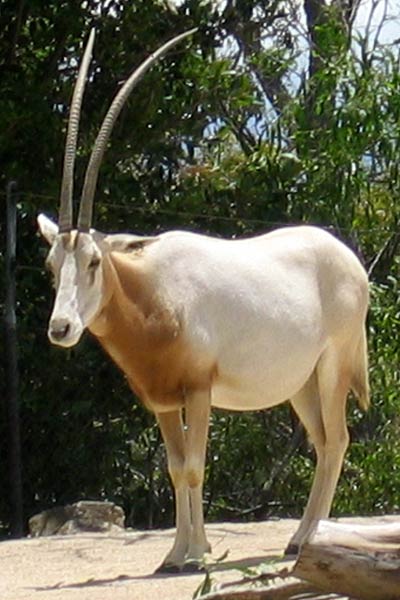| New Photos | Animal News | Animal Sounds | Animal Movies | Upload Photo | Copyright | Korean |
|---|
| Funny Animal Photos | Monsters in Animalia | Wiki Articles Fun Facts about Animals | Links | Home | Mobile A.P.A. |
|---|
| Image Info | Original File Name: Scimitar-horned Oryx (Oryx dammah).jpg Resolution: 400x600 File Size: 46033 Bytes Upload Time: 2007:10:16 22:31:26 | |
| Author | Name (E-mail): Unknown | |
| Subject | Scimitar Oryx (Oryx dammah) - Wiki | |
 |
| Email : E-Card | Poster | Web Master Delete Edit Info Admin |
| Description | Scimitar Oryx (Oryx dammah) - Wiki
Scimitar Oryx
The Scimitar Oryx, or Scimitar-Horned Oryx, (Oryx dammah) is a species of oryx which formerly inhabited the whole of North Africa. Today conflicting reports exist as to whether it is extinct in the wild, or whether small populations survive in central Niger and Chad. Appearance The Scimitar Oryx is just over a metre at the shoulder and weighs around two hundred kilograms. Its coat is white with a red-brown chest and black markings on the forehead and down the length of the nose. The horns are long, thin and parallel and curve backwards (like a scimitar) and can reach a metre to a metre and a quarter on both sexes, male and female. Ecology Scimitar Oryx natively inhabit steppe and desert where they eat leaves, grass and fruit. They form herds of mixed sex containing up to seventy animals. Formerly they would gather in groups of several thousand for migration. Scimitar Oryx can survive without water for many weeks, because their kidneys prevent loss of water from urination and they can modify their body temperature to avoid perspiration. Conservation Scimitar Oryx were hunted for their horns, almost to extinction. Where once they occupied the whole Sahara, they are now considered to be extinct in the wild, although there have been unconfirmed sightings in Chad and Niger. A global captive breeding programme was initiated in the 1960s. In 1996, there were at least 1,250 captive animals held in zoos and parks around the world with a further 2,145 on ranches in Texas. A herd exists in a fenced nature preserve in Tunisia, and is being expanded with plans for reintroduction to the wild in that country. http://en.wikipedia.org/wiki/Scimitar_Oryx
| |||
| Copyright Info | AnimmalPicturesArchive.com does not have the copyright for this image. This photograph or artwork is copyright by the photographer or the original artist. If you are to use this photograph, please contact the copyright owner or the poster. |
|
|
|
| |||||||
| CopyLeft © since 1995, Animal Pictures Archive. All rights may be reserved. | ||||||||
Stats